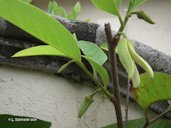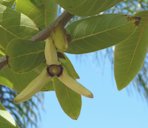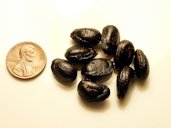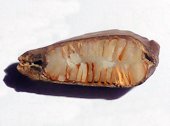| Cherimoya - Annona cherimola | |||||||||||||||
|---|---|---|---|---|---|---|---|---|---|---|---|---|---|---|---|
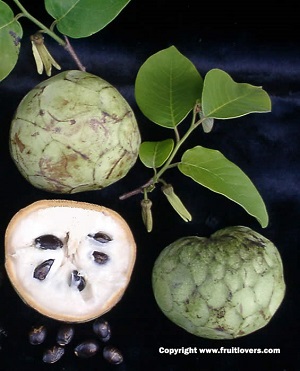 Fig. 1  Annona cherimola 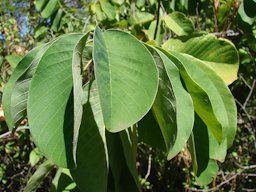 Fig. 2  A. cherimola (leaves)  Fig. 3  Cherimoya A. cherimola, California 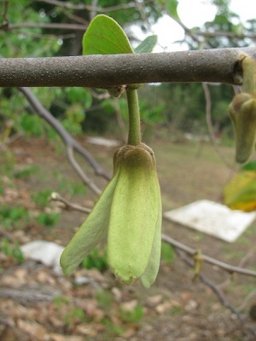 Fig. 4 Flowers at Ulupalakua Ranch, Maui 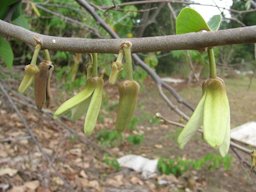 Fig. 5  Flower habit 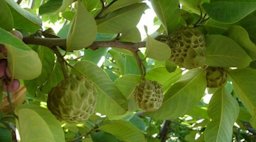 Fig. 8  Cherimoya fruiting habit, Mexico 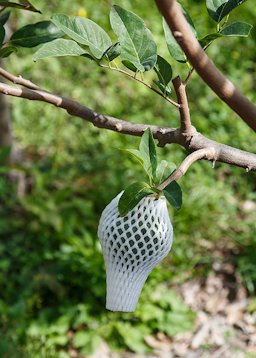 Fig. 9 A cherimoya fruit, growing in a protective cover on a plantation in Bin Lang Village, Taiwan 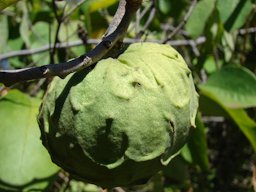 Fig. 10  A. cherimola (fruit) 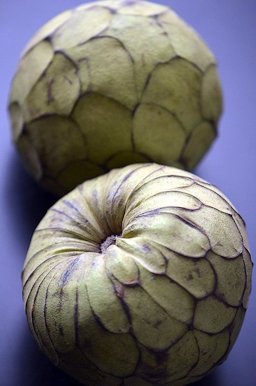 Fig. 11 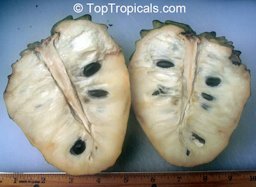 Fig. 12 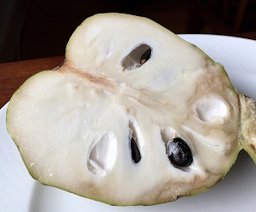 Fig. 13 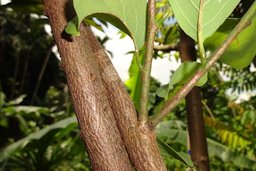 Fig. 17  Fig. 18 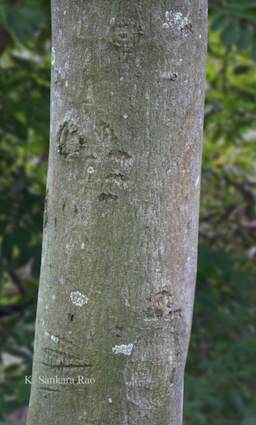 Fig. 19  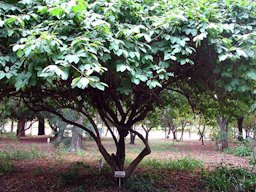 Fig. 20  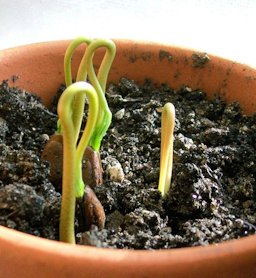 Fig. 21  Sprouts emerging from cherimoya seeds, supermarket fruit in North Carolina 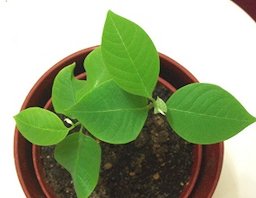 Fig. 22 Seedling cherimoyas; these were sprouted from seeds taken from a supermarket fruit in about 3 weeks 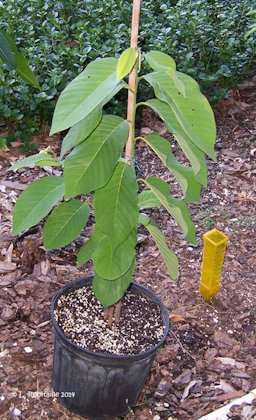 Fig. 23  W. Clifton 'Dream' cherimoya, 2009  Fig. 24  Cherimoya ready to eat 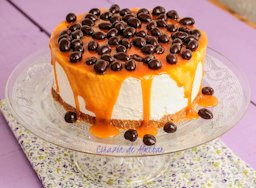 Fig. 25  Pastel mousse de chirimoya Fig. 26  Mousse de Chirimoya, a mousse made with Peruvian cherimoya 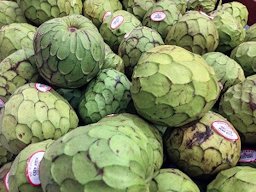 Fig. 27 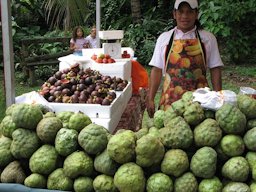 Fig. 28  Cherimoya (A. cherimola) on sale in Cali, Colombia. |
Scientific
name Annona cherimola Miller Common names English: cherimoya, cherimoyer, annona; Belize: tukib; Chinese: mao ye fan li zhi; El Salvador: anona poshte; Dutch: cherimolia; French: anone, chérimolier; German: Chirimoyabaum, Cherimoyer, Cherimolia, peruanischer, Flaschenbaum, Flachsbaum; Haiti: cachiman la Chine; Italian: cerimolia; Mexico: pox or poox; Portuguese (Brasil): atemóia, cherimóia, graveola, graviola, or grabiola; Spanish: chirimoya, cherimoya, cherimalla, cherimoyales, anona del Perú, chirimoyo del Perú, cachimán de la China, catuche, momona, girimoya, masa; Swedish: Kirimoja; Indian names in Guatemala: pac, pap, tsummy and tzumux; Quechua: chirimuya; Aymara: yuructira 1,9,11 Synonyms A. pubescens Salisb; Annona tripetala Aiton 9 Relatives Ilama (A. diversifolia), pond apple (A. glabra), Manrito (A. jahnii). mountain soursop (A. montana), soursop (A. muricata), soncoya (A. purpurea), bullock's heart (A. reticulata), sugar apple (A.squamosa), atemoya (A. cherimola x A. squamosa) 1 Family Annonaceae (annona family) Origin Research suggests a meso-American origin 10 Uses Fruit Height 16-30 ft (5-9 m) 1 Spread Dense spreading crown Growth rate Slow Trunk/bark/branches Bark grey; relatively smooth; low spreading branches Pruning requirement Train to 2 scaffold branches; severe pruning (2/3 of new growth) to aid in picking; shoots that are approximately 60 degrees from trunk are normally saved 2 Leaves Briefly deciduous; alternate; ovate to elliptical; slightly furry on underside; short hairs on upper surface Flowers Axillary sub-petiolar buds are compound (3 vegetative and 2 flowering) 10 Fruit Texture of a soft, non-gritty pear; delicate fruit flavor with little acidity; brown hard glossy seeds Season Oct. to May USDA Nutrient Content pdf Light requirement Sun Soil tolerances Prefers rich, loamy, well drained soil with uniform moisture 4 pH preference 6.5-7.6 1,6,7 Drought tolerance Drought tolerant and does not tolerate standing water Aerosol salt tolerance Need protection from constant ocean winds which may damage them and interfere with pollination and fruit set 7 Cold tolerance 27 °F (-2.8 °C), it is the most cold tolerant of the commercial Annona species Wind tolerance Should be protected from strong winds which interfere with pollination and fruit set 1 Plant spacing 20-25 ft (3-4.5 m) Roots Tap root but shallow root system Invasive potential * None reported Pest resistance See below Known hazard The seeds, leaves, and limbs contain poisonous alkaloids that have been used to kill lice 2 Reading Material Cherimoya, Fruits of Warm Climates Cherimoya, Twelve Fruits Project, University of Hawai'i at Mānoa Cherimoya, California Rare Fruit Growers The Cherimoya, Manual Of Tropical And Subtropical Fruits Cherimoya, Lost Crops of the Incas Origin This has long been thought to be the highlands of Ecuador & Peru but recent molecular evidence suggests a meso-American origin. It is now grown in several sub-tropical countries, with Spain currently the world's largest producer. 10 The name Cherimoya originates from the Quechua word chirimuya, which means “cold seeds,” because the plant grows at high altitudes and the seeds will germinate at higher altitudes. 1 It is in the large Annonaceae family, one of the oldest (ancestry of about 95 million years) in the flowering plants, that contains about 130 genera and 2400 species. There are approximately 175 species in the genus Annona which diverged about 25 million years ago; several of these plus one hybrid (atemoya) are grown commercially around the world for fruit. Some of the common ones are sugar apple, soursop, mountain soursop, pond apple, bullock's heart, rollinia, and atemoya which is a hybrid between A. cherimola and A. squamosa. Molecular genetics shows these two are the closest relatives amongst the fruiting species. 10 Description The tree is erect but low branched and somewhat shrubby or spreading; ranging from 16 to 30 ft (5 to 9 m) in height; and its young branchlets are rusty-hairy. The leaves are briefly deciduous (just before spring flowering), alternate, 2-ranked, with minutely hairy petioles ¼ to ½ in. (6 to 12.5 mm) long; ovate to elliptic or ovate-lanceolate, short blunt-pointed at the apex; slightly hairy on the upper surface, velvety on the underside; 3 to 6 in. (7.5-15 cm) long, 1 ½ to 3 ½ in. (3.8-8.9 cm) wide. 1 Flowers Dichogamous flowering habit; borne solitary or groups of 2 or 3 on short, hairy stalks along the branches; pendulous; three outer, greenish, fleshy, oblong, downy petals; green to brown exterior, white interior; 1-2 in. (2.5-5 cm) long. 1,2
Fig. 6. W. Clifton 'Dream' cherimoya flowers Fig. 7. A. cherimola, San Diego Fruit Fruit is formed by the fusion or partial fusion of the carpels resulting in a more or less bumpy fruit with many seeds. Cherimoyas ripen in 5 to 8 months after pollination. 2 The skin, thin or thick, may be smooth with fingerprint like markings or covered with conical or rounded protuberances. The fruit is easily broken or cut open, exposing the snow-white, juicy flesh, of pleasing aroma and delicious, subacid flavor; and containing numerous hard, brown or black, beanlike, glossy seeds, ½ to 3/4 in (1.25 to 2 cm) long. The fruit turns a pale green or creamy yellow color as they reach maturity. They should be picked when still firm and allowed to soften at room temperature. Ripe fruit will give to soft pressure. 1 Cherimoya is a climacteric fruit and when it ripens, fruit contours become smoother. 10
 Fig. 16  Fig. 14. Several seeds from a cherimoya Fig. 15. Seed, longitudinal section Skin types The skin can be smooth or have varying protruberances that derive from separate but loosely fused carpels. These protruberances have been used to broadly classify fruit into 5 types: 10 Mammillate - forma mamillata (bumpy); Umbonate - (the fruit is oblong-conical, with the base somewhat umbilicate and the surface studded with protuberances, small lumps, each of which corresponds to a component carpel); Impressa (smooth or slightly Indented; finger printed); Tuberculate -forma tuberculata (the fruit is heart-shaped and has wart-like tubercles near the apex of each areole). 8 Varieties Mr. Har Mahdeem, popular horticultural circuit speaker and authority on Annonaceae, did not recommend growing this annona because our climate is too humid. He recommends only the ‘Fina de Jete' from Spain as it produces reasonably well. The leaf is fuzzy and round as against the long and pointy leaf of the custard-apple. The commercial cultivars include 'Bay Ott', 'Chaffey', 'Dr White', 'Libby', 'Nata', 'Orton' and 'Spain'. 3 'Dream', W. Clifton's named cultivar: "You have a cherimoya (Annona cherimola). It's a very special fruit tree because cherimoyas do not grow here. They are a high elevation plant and don't like the heat and humidity. Mine is different. It takes any weather, heat, humidity, and cold. I had it verified by our head botanist/scientist at the Division of Plant Industry in Gainesville, Florida Dept. of Agriculture. I have worked on this tree for 14 years before releasing it. I have named it Cherimoya 'Dream' because it's an absolute dream to eat. In the spring, I will nip the longer branches back 6" or so and strip 4 or 5 leaves off the branch from the end back. I have found that it will throw out branches from the dormant buds where the leaves were and each branch will produce several blooms." Wayne Clifton (2009) Harvesting The fruits are particularly vulnerable to climatic adversity: if caught by cold weather before maturity, they ripen imperfectly; if rains are heavy or sun excessive, the large ones crack open; and if humidity is high, they rot before they can be picked. 11 The fruits must be picked by hand, and, because they mature at different times, each tree may have to be harvested as many as 10 times. In addition, the picked fruits are difficult to handle. Even when undamaged, they have short storage lives (for example, 3 weeks at 10°C) unless handled with extreme care. 11 Pollination The annona family exhibits a protogynous dichogamous flowering habit, that is, complete flowers in which the stigma is receptive before the pollen is ready to shed from the anthers. This condition is very important in cherimoya since the configuration of its flowers is not conducive to pollination by natural means. Therefore, pollination is done by hand: pollen is usually collected in the late afternoon or evening, stored in a cool place, and applied to the mature stigmas which are usually receptive in the morning. 2 The pollen has its highest viability at the time it is shed and declines significantly with time. Immediately apply freshly collected pollen with a small brush to the flowers in partially open, female stage (see video below). 7 Beetles are the natural pollinators attracted mainly by odours emitted during the female stage. Wind and other insects play a much smaller role (1-2%); a major limitation with wind dispersal is due to pollen being released in heavy clumps of 4 (tetrads rather than monads). In most countries hand-pollination is necessary for good yields and fruit shape. 10 Pollination is perhaps the cherimoya's biggest technical difficulty. Not only are reliable pollinators missing in some locations, but low humidity, especially when combined with high temperatures, causes pollination failure; these conditions dry out the sticky stigmas, and the heavy pollen falls off before it can germinate. 11 Flowering Behavior, Pollination, and Fruit Set, University of Florida Key Issues: Pollination, The State of Queensland (through the Department of Agriculture and Fisheries) Hand Pollination of Custard Apples, Archives of the Rare Fruit Council of Australia
Propagation Although seedlings have a good probability of producing acceptable fruit, trees are normally grafted or budded on seedling rootstock to ensure reliable results. Grafting is done in the spring at or before leaf drop. Scion wood should be collected just before leaf drop. Plants also can be rooted from cuttings, although it is somewhat difficult. 2 To induce swelling of the sub-petiolar buds, foliage should be removed 1-2 weeks before grafting. There are some graft incompatibilities across the Annona fruiting species, but named variety cherimoya scions can be successfully grafted onto atemoya, sugar apple and of course self-grafted, and can also serve as root stocks for sugar apple. 10 For stock-plants on which to bud or graft the cherimoya in Florida A. squamosa has proved to be a good stock when a dwarf tree is desired; A. glabra tends to outgrow the scion. 8 Grafting Annonas in Southern Florida, Hort Science pdf
Culture The subtropical cherimoya prefers higher elevations, to 5000 feet, but will bear fruit as low as 800 feet. 12 Coastal regions with higher relative humidity (RH, 70-80%) in spring and summer fare better than drier inland areas. It requires 50-100 chill hours before flowering and can also tolerate some drought periods; excessive precipitation is detrimental. 10 A wide range of soils is tolerated from sandy to clay loams. The tree seems particularly adapted to high-calcium soils, on which it bears abundant fruits of superior flavor. 10,11 Soil moisture should be maintained but good drainage is essential to avoid root rot. 10 Pruning Shaping the young trees is important to fruit production. Limbs need to be able to support the heavy fruits, which can weigh more than 2 pounds. Usually two or three lower limbs that angle upward at about 60 degrees from the trunk are saved. The style adopted is called the open goblet. Prune during the rest period when leaves begin to fall shortly after harvest is completed. Tip rapidly growing shoots to encourage flowering. 4 Young trees "harp," forming opposite branches as a natural espalier. These can be trained against a surface, or pruned off to form a regular free-standing trunk. 7 How to Espalier your Tree Fertilizing Cherimoya usually requires extra potassium for good production, up to 10 pounds per year for mature trees. 4 Cherimoyas respond to fertilizer applications generally provided every 3 months with a balanced fertilizer such as 8-8-8. Yellow leaves may not indicate a need for fertilizer but may be a response to cold temperatures or to the soil being too dry or wet. 2 Irrigation The trees are watered except during the winter when they must be allowed to go dormant ideally for 4 months. When the first leaf buds appear, irrigation is resumed. With bearing trees, watering is discontinued as soon as the fruits are full-grown. 6 Pest Page The cherimoya tree is resistant to nematodes. 1 Ants are a problem since they promote mealy bugs on the fruit. Ants are most easily controlled by limiting access from the ground by placing a mechanical or acceptable chemical barrier on the trunk of the tree. 2 Diseases Cherimoyas are susceptible to Armillaria (Oak root fungus) and Verticillium sp. and should not be planted in old vegetable gardens, near tomatoes, eggplant or asters. 6 Food Uses The white flesh of the ripe cherimoya is sweet, juicy and very fragrant. It is most commonly eaten out of-hand or scooped with a spoon from the cut open fruit. In Mexico, sometimes people add a few drops of lime juice. Occasionally it is seeded and added to fruit salads or used for making sherbet or ice cream. Colombians strain out the juice, add a slice of lemon and dilute with ice-water to make a refreshing soft drink. 6 Fruit flesh represents 65-80% of fruit weight. The carbohydrate level can exceed 20% (mainly glucose and sucrose) and the major acids are citric and malic. Usually as fruit ripen flesh acidity decreases, but with cherimoya it increases. 10 Medicinal Properties ** In Mexico, rural people toast, peel and pulverize 1 or 2 seeds and take the powder with water or milk as a potent emetic and cathartic. Mixed with grease, the powder is applied on parasitic skin disorders. A decoction of the skin of the fruit is taken to relieve pneumonia. 6 Other Uses In Jamaica, the dried flowers have been used as flavoring for snuff. 1 The fruit is fermented to produce an alcoholic beverage. 6 General Annona squamosa resembles the cherimoya in texture and flavor and, since it is the more widely adaptable to humid conditions, it is the most widely planted in the more tropical parts of the world. 2 William F. Whitman, in a letter to the editor of the California Rare Fruit Growers, also explains "...the failure to grow cherimoyas in Florida is climate. Because of our hot, humid weather, cherimoyas grow very poorly and they fruit at all it is only the size of a small lemon and unfit to eat."
Poison Blindness can result from the juice of the crushed seeds coming in contact with the eyes. The seeds contain several alkaloids: caffeine, (+)-reticuline, (-)-anonaine, liriodenine, and lanuginosine. Human ingestion of 0.15 g of the dark-yellow resin isolated from the seeds produces symptoms resembling the effects of atropine. The twigs possess the same alkaloids as the seeds plus michelalbine. 8 alkaloids have been reported in the leaves: (+)-isoboldine, (-)-stepholidine, (+)-corytuberine, (+) nornantenine, (+)-reticuline, (-)-anonaine, liriodenine, and lanuginosine. 6 Other Edibles in the Annona genus: Atemoya (A. cherimola x A. squamosa) Biriba (Rollinia mucosa, A. mucosa) Custard Apple (A.reticulata) Ilama (A. macroprophyllata) Mountain Soursop (A. montana) Pond Apple (A. glabra) Poshte (A. scleroderma) Soursop (A. muricata) Sugar apple (A. squamosa) Further Reading Annona cherimola Mill, Agroforestree Database Cherimoya: Postharvest Quality-Maintenance Guidelines, University of Hawai'i, CTAHR pdf Cherimoya Botanical Art List of Growers and Vendor |
||||||||||||||
| Bibliography 1 Fruits of Warm Climates. Julia F. Morton, Miami, 1987. 2 Vieth, Robert. "Cherimoya." University of California Cooperative Extension, Agriculture and Natural Resources, Ventura County, ucanr.edu . Accessed 4 Jan. 2014. 3 Mahdeem, H. "Custard Apples." Neglected crops: 1492 from a different perspective, FAO Plant Production and Protection Series, no. 26, Food and Agriculture Organization of the United Nations, 1994, FAO, fao.org. Accessed 26 Dec. 2015. 4 Love, Ken, et al. "Cherimoya." Twelve Fruits With Potential Value-Added and Culinary Uses, University of Hawai‘i at Mānoa, College of Tropical Agriculture and Human Resources, 2007. Accessed 17 Mar. 2016. 5 RoRo. "Flower morphology - longitudinal section chirimoya, Annona." Wikimedia, 2013, (CC0 1.0), wikimedia.org. Accessed 30 Dec. 2015. 6 Orwa C., et al. "Annona cherimola Mill." Agroforestree Database:a tree reference and selection guide version 4.0, 2009, www.worldagroforestry.org. Accessed 30 Dec. 2015. 7 "Cherimoya." California Rare Fruit Growers, crfg.org. Accessed 2014. 8 Popenoe, Wilson. Manual Of Tropical And Subtropical Fruits. 1920, London, Hafner Press, 1974. 9 "Taxon: Annona cherimola Mill." USDA, Agricultural Research Service, U.S. National Plant Germplasm System, GRIN-Global, npgsweb.ars-grin.gov/gringlobal/taxonomydetail.aspx?id=3479. Accessed 7 Aug. 2021. 10 "Cherimoya, Chirimoya, Annona cherimola." The Rare Fruit Club WA, www.rarefruitclub.org.au/Cherimoya.htm, Accessed 8 Aug. 2021. 11 "Cherimoya." Lost Crops of the Incas: Little-Known Plants of the Andes with Promise for Worldwide Cultivation, National Research Council (U.S.), Advisory Committee on Technology Innovation, 1989, Internet Archive, Public Domain, archive.org/. Accessed 7 Aug. 2021. 12 Love, Ken, et al. "Twelve Fruits With Potential Value-Added and Culinary Uses." HawaiiFruit.net, University of Hawai'i at Mānoa, College of Tropical Agriculture and Human Resources, 2007, CTAHR, www.hawaiifruit.net/12trees.html. Accessed 17 Mar. 2016. Videos v1 "Hand Pollinating Annonas with Har." Truly Tropical, 29 May 2019, (CC0), www.youtube.com/watch?v=sB9Mhjq9UZc. Accessed 6 Aug. 2021. v2 "How to Graft Annona Fruit Trees Using Cleft Graft - Grafting Dream Cherimoya, Atemoya, etc." Sulcata Grove, 26 Feb. 2017, www.youtube.com/watch?v=1_Xy-rZQmdg. Accessed 23 July 2021. Photographs Fig. 1 Jaitt, Oscar. "Cherimoya, Annona cherimola." Fruitlover's Nursery, fruitlovers.com. Accessed 22 Sept. 2014. Fig. 2 Starr, Forest and Kim. "Annona cherimola (leaves). Maui, Enchanting Floral Gardens of Kula." Starr Environmental, 2007, (CC BY 4.0), starrenvironmental.com. Accessed 30 Dec. 2015. Fig. 3 Marcial, Neptalí Ramírez. "Cherimoya Annona cherimola, California." iNaturalist, Research Grade, no. 29949335, 31 July 2019, (CC BY-NC 4.0), www.inaturalist.org/observations/29949335. Accessed 8 Aug. 2021. Fig. 4,5 Starr, Forest and Kim. "Flowers at Ulupalakua Ranch, Maui." Starr Environmental, 2008, (CC BY 4.0), starrenvironmental.com. Accessed 22 Sept. 2014. Fig. 6,23 Robitaille, Liette. "'Dream' Cherimoya Series." 2009, 2014, www.growables.org. Fig. 7 Bárbol. "Annona cherimola, San Diego." Flickr, 18 Aug. 2016, (CC BY-NC-SA 2.0), www.flickr.com/photos/10770266@N04/28985947691/. Accessed 8 Aug. 2021. Fig. 8 Ortega, Rivera, Cesar. "Cherimoya Annona cherimola. Mexico." iNaturalist, Research Grade, no. 66668721, 16 Dec. 2020, (CC BY-NC 4.0), www.inaturalist.org/observations/66668721. Accessed 8 Aug. 2021. Fig. 9 CEphoto, Uwe Aranas. "A cherimoya fruit, growing in a protective cover on a plantation in Bin Lang Village, Taiwan." Wikipedia, 1 Jan. 2016, (CC BY-SA 3.0), en.wikipedia.org/wiki/Cherimoya#/media/File:Bin_Lang_Taiwan_Cherimoya-fruits-01.jpg. Accessed 8 Aug. 2021. Fig. 10 Starr, Forest and Kim. "Annona cherimola (fruit). Maui, Enchanting Floral Gardens of Kula." Starr Environmental, 2007, (CC BY 4.0), starrenvironmental.com. Accessed 30 Dec. 2015. Fig. 11 Stansbury, Gwendolyn. "How to Eat a Cherimoya (Chirimoya)." Perennial Pastimes, 15 Apr. 2015, (CC BY-NC-ND 3.0), perennialpastimes.com/2015/04/15/how-to-eat-a-cherimoya-chirimoya/. Accessed 8 Aug. 2021. Fig. 12 "Annona cherimola." Top Tropicals, toptropicals.com. Accessed 22 Sept. 2014. Fig. 13 Mr.TinDC. "Inside of a cherimoya." Flickr, 2015, (CC BY-NC-ND 2.0), flickr.com. Accessed 30 Dec. 2015. Fig. 14 Badagnani. Several seeds from a cherimoya, with a United States penny at left, for comparison." Wikimedia, 2008, GFDL, wikimedia.org. Accessed 30 Dec. 2015. Fig. 15,16 Philmarin. "Annona cherimola (chirimoya seed )." Wikimedia, 2013, (CC BY-SA 3.0), wikimedia.org. Accessed 30 Dec. 2015. Fig. 17,18 Kwan. "Annona cherimola." Plant Observatory, 2013, natureloveyou.sg. Accessed 3 Jan. 2015. Fig. 19 Sankara Rao, K., et al. "Annona cherimola Mill." Flora of Peninsular India, 2019, (CC BY-NC 4.0), peninsula.ces.iisc.ac.in/plants.php?name=Annona cherimola. Accessed 8 Aug. 2021. Fig. 20 Aibdescalzo. "Ejemplar de Annona cherimola, en el Jardín Botánico de la ciudad de La Plata." Wikimedia, 2009, GFDL, wikimedia.org. Accessed 30 Dec. 2015. Fig. 21 Davidals. "Sprouts emerging from cherimoya seeds, from a supermarket fruit in North Carolina." Wikimedia, 2010, (CC BY-SA 3.0), wikimedia.org. Accessed 30 Dec. 2015. Fig. 22 David. "Seedling cherimoyas; these were sprouted from seeds taken from a supermarket fruit in about 3 weeks." Flickr, 2010, (CC BY 2.0), flickr.com. Accessed 30 Dec. 2015. Fig. 24 Starr, Forest and Kim." Fruit ready to eat at Enchanting Floral Gardens of Kula, Maui." Starr Environmental, 2012, (CC BY 4.0), starrenvironmental.com. Accessed 22 Sept. 2014. Fig. 25 Ruiz, Ana. "Pastel Mousse de Chirimoya." Corazón de Almíbar, 28 Nov. 2013, (CC BY-NC-ND 2.5 ES), corazondealmibar.blogspot.com/2013/11/pastel-mousse-de-chirimoya.html?spref=pi. Accessed 7 Aug. 2021. Fig. 26 "Mousse de Chirimoya, a mousse made with Peruvian cherimoya." Peru Food Blog, The Art of Peruvian Cuisine, 4 Feb. 2007, (CC BY-NC-SA 2.5), perufood.blogspot.com/2007/02/peruvian-desserts.html. Accessed 9 Aug. 2021. Fig. 27 Couse-Baker, Robert. "Cherimoya. Bought one, but it's too green to eat until it ripens." Flickr, 2013, (CC BY 2.0), flickr.com. Accessed 30 Dec. 2015. Fig. 28 NusHub. "Cherimoya (Annona cherimola) on sale in Cali, Colombia. In left background: domestically produced mangosteen (Garcinia mangostana)." Crops for the Future, Wikipedia, 18 Nov. 2007, (CC BY-SA 3.0), en.wikipedia.org/wiki/Neglected_and_underutilized_crop#/media/File:Cherimoya_(Annona_cherimola)_in_Cali_Colombia.JPG. Accessed 8 Aug. 2021. Fig. 29 Anuragi, H., et al. "Molecular diversity of Annona species and proximate fruit composition of selected genotypes." 3 Biotech, Springer Nature, 23 Sept. 2016, (CC BY 4.0), doi.org/10.1007/s13205-016-0520-9. Accessed 5 Aug. 2021. * UF/IFAS Assessment of Non-native Plants in Florida's Natural Areas ** Information provided is not intended to be used as a guide for treatment of medical conditions. Published 29 Dec. 2014 LR. Last update 24 Dec. 2024 LR |
|||||||||||||||
